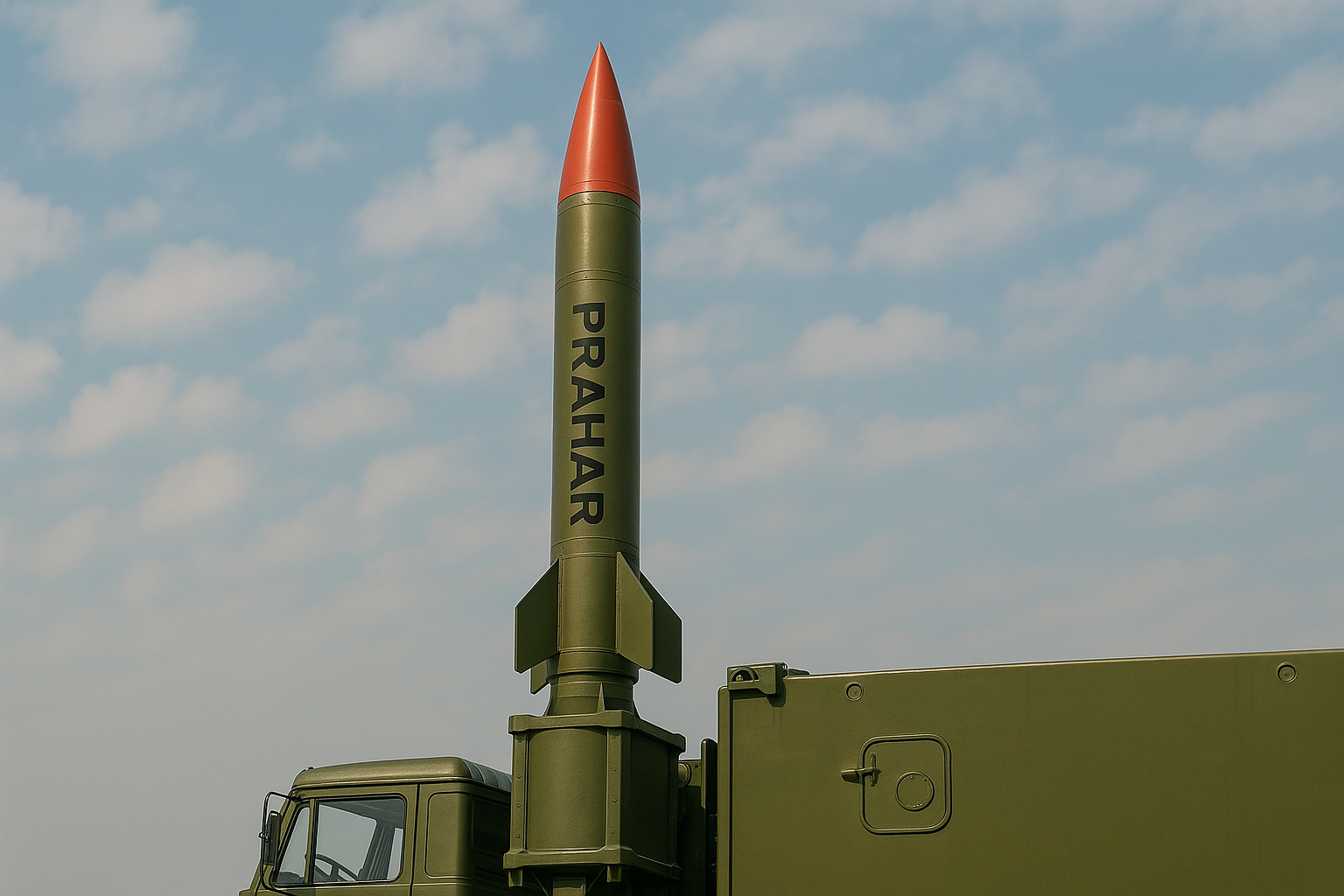INTRODUCTION TO PRAHAR MISSILE
The Prahar missile is a tactical surface-to-surface missile developed by India’s Defence Research and Development Organisation (DRDO). Designed to fill the gap between multi-barrel rocket systems like Pinaka and ballistic missiles like Prithvi, Prahar offers a swift and highly accurate strike capability. With its quick deployment, mobile platform, and precision targeting, Prahar significantly enhances India’s conventional deterrence posture.
KEY FEATURES OF THE PRAHAR MISSILE
TYPE AND ROLE
Category: Short-range tactical surface-to-surface missile
Role: Quick-reaction battlefield support, neutralizing high-value targets such as command posts, air defense sites, and logistics hubs
RANGE
Striking range: Approximately 150 km
Fills the tactical void between the Pinaka MBRL (40–75 km) and Prithvi series (250–350 km)
GUIDANCE SYSTEM
Equipped with an Inertial Navigation System (INS), with potential GPS/GLONASS support
High accuracy with Circular Error Probability (CEP) less than 10 meters
WARHEAD
Capable of carrying conventional warheads up to 200 kg
Designed for high-impact strikes with minimal collateral damage
LAUNCH PLATFORM
Mounted on road-mobile launchers, allowing rapid relocation and firing
A single launcher can fire up to six missiles in quick succession
DEVELOPMENT TIMELINE
2011: First successful test conducted by DRDO at the Integrated Test Range (ITR), Odisha
Post-2011: Continuous improvements made in range, reaction time, and targeting accuracy
Strategic Fit: Tailored to support India’s Cold Start doctrine for swift tactical response
COMPARISON WITH OTHER INDIAN MISSILES
| Missile | Type | Range | Use Case |
|---|---|---|---|
| Prahar | Tactical Ballistic | ~150 km | Precision strike on battlefield |
| Pinaka | Multi-Barrel Rocket | 40–75 km | Area saturation attack |
| Prithvi | Short-Range Ballistic | 250–350 km | Deep strategic targeting |
| BrahMos | Supersonic Cruise | 300–500 km | Fast, high-precision strike |
| Agni Series | Intermediate/ICBM | 700–5,000+ km | Strategic deterrence |
STRATEGIC SIGNIFICANCE OF PRAHAR
Rapid Response: Designed for quick mobilization and deployment during high-tension periods
Tactical Flexibility: Ideal for front-line deployment against enemy positions or installations
Low Collateral Impact: Offers controlled targeting with high accuracy
Complementary Role: Bridges the gap between artillery and strategic missile systems
Counterforce Capability: Capable of striking enemy targets without triggering strategic escalation
EXPORT POTENTIAL AND FUTURE UPGRADES
With India’s growing defense partnerships, Prahar holds export potential for friendly nations
Future variants may include satellite navigation integration for even better targeting
Scope exists for extended-range versions under international treaty compliance
CONCLUSION
The Prahar missile is a clear testament to India’s growing capability in indigenous defense technology. With its combination of mobility, accuracy, and rapid deployment, Prahar provides the Indian Armed Forces with a powerful tactical edge in modern warfare. Its role is vital in reinforcing India’s ability to deliver swift, decisive battlefield outcomes without escalating conflicts beyond the tactical level.
FREQUENTLY ASKED QUESTIONS (FAQs)
Q1. What is the range of the Prahar missile?
The Prahar missile has an operational range of approximately 150 kilometers.
Q2. Who developed the Prahar missile?
The missile was developed by India’s Defence Research and Development Organisation (DRDO).
Q3. Is Prahar capable of carrying nuclear warheads?
No, the Prahar missile is designed to carry only conventional warheads.
Q4. How is Prahar different from the Prithvi missile?
Prahar is a tactical missile with shorter range and quicker response time, while Prithvi is used for strategic-level targeting.
Q5. Can Prahar be launched from different terrains?
Yes, Prahar is road-mobile and can be launched from various terrains, making it suitable for battlefield use.
Q6. Has Prahar been inducted into the Indian Army?
While official induction status is not publicly confirmed, multiple successful tests indicate readiness for operational deployment.







